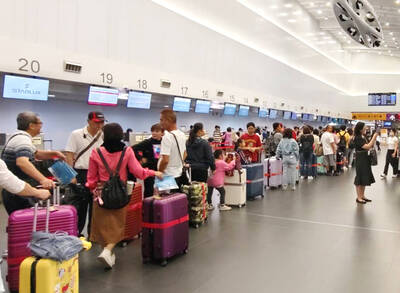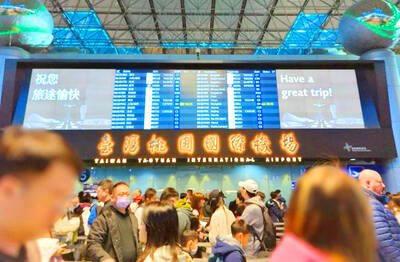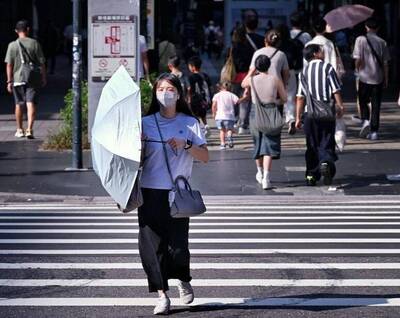The US Federal Communications Commission (FCC) on Wednesday approved Google’s request to use part of a US-Asia undersea telecommunications network that is to take data to and from Taiwan under the Pacific Ocean.
Google agreed to operate the Pacific Light Cable Network System link between the US and Taiwan, but was not authorized to use the US-Hong Kong section.
The US Department of Justice on Wednesday urged the FCC to give Google owner Alphabet Inc permission to start using the connection between Los Angeles and Yilan County’s Toucheng Township (頭城).
However, the justice department rejected use of the connection between the US and Hong Kong.
“There is a significant risk that the grant of a direct cable connection between the United States and Hong Kong would seriously jeopardize the national security and law enforcement interests of the United States,” the justice department said, with the decision backed by the US departments of homeland security and national defense.
The FCC is allowing Google to operate the Taiwan link for the next six months, pending a final disposition of the application.
Google told regulators this year that it has “an immediate need to meet internal demand for capacity between the US and Taiwan, in particular to connect Google’s Taiwan data center to Google data centers in the United States and to serve users throughout the Asia-Pacific region.”
Without that “capacity, the value of large, recent capital investments Google has made in the United States is significantly reduced,” it said.
The justice department said that without temporary authority, “Google would likely have to seek alternative capacity at significantly higher prices.”
Google has also agreed to “pursue diversification of interconnection points in Asia,” as well as to establish network facilities that deliver traffic “as close as practicable” to its ultimate destination, the justice department said.
The US has expressed concerns about China’s role in handling network traffic and the potential for espionage. About 300 subsea cables form the backbone of the Internet, carrying 99 percent of global data.
A Facebook affiliate sought FCC approval to use a portion of the cable connecting the Philippines and the US to handle traffic.
Facebook on Wednesday said that it is “navigating through all the appropriate channels on licensing and permitting.”
Construction of the Google submarine cable connecting Taiwan and California was completed at the end of last year, the National Communications Commission (NCC) said yesterday, adding that Chunghwa Telecom would have to secure the commissions’ consent before it is allowed to use the infrastructure.
The Google cable is a partnership between Chunghwa Telecom and the US firm, NCC spokesman Hsiao Chi-lung (蕭祈宏) said, adding that Chunghwa in 2017 filed an application to build the cable.
Both have started testing the cable’s reliability, Hsiao said, adding that Chunghwa needs to secure the NCC’s approval to access it.
Officials must ascertain that use of the cable would not present potential threats to national security, which the NCC should take into account when it reviews the telecom’s application, he said.
Lee Ming-chung (李明忠), head of the NCC’s fixed network telecommunications division, said that the primary link of the Pacific Light Cable Network System is the one between the US and Hong Kong.
The one linking Taiwan and the US is a branch, Lee said.
The telecom joined the project amid increasing demand for the bandwidth, he said.
There is about 13,506km of cable in the network, but the telecom did not provide the length of the link between Taiwan and the US in its 2017 application, Lee said.
As the NCC has designated international undersea cables as critical national infrastructure in an amendment to telecommunications regulations, the telecom must ensure that it does not use any communications equipment manufactured in China, he said.
The telecom is also obligated to comply if law enforcement officials submit legal requests to obtain data transmitted through the cable, he said.
Chunghwa Telecom is still conducting tests on the cable, the company said, adding that the countries that have Pacific Light Cable Network System links should seek permission from their authorities to activate them.
The network would make a final announcement on when the cables would begin operations, it said.
Google, Facebook and Pacific Light Data Communication are collaborating on the project.
Google has its largest data center in Asia in Changhua County, which it has been operating since Dec. 11, 2013.

Three Taiwanese airlines have prohibited passengers from packing Bluetooth earbuds and their charger cases in checked luggage. EVA Air and Uni Air said that Bluetooth earbuds and charger cases are categorized as portable electronic devices, which should be switched off if they are placed in checked luggage based on international aviation safety regulations. They must not be in standby or sleep mode. However, as charging would continue when earbuds are placed in the charger cases, which would contravene international aviation regulations, their cases must be carried as hand luggage, they said. Tigerair Taiwan said that earbud charger cases are equipped

Foreign travelers entering Taiwan on a short layover via Taiwan Taoyuan International Airport are receiving NT$600 gift vouchers from yesterday, the Tourism Administration said, adding that it hopes the incentive would boost tourism consumption at the airport. The program, which allows travelers holding non-Taiwan passports who enter the country during a layover of up to 24 hours to claim a voucher, aims to promote attractions at the airport, the agency said in a statement on Friday. To participate, travelers must sign up on the campaign Web site, the agency said. They can then present their passport and boarding pass for their connecting international

Temperatures in northern Taiwan are forecast to reach as high as 30°C today, as an ongoing northeasterly seasonal wind system weakens, the Central Weather Administration (CWA) said. CWA forecaster Tseng Chao-cheng (曾昭誠) said yesterday that with the seasonal wind system weakening, warmer easterly winds would boost the temperature today. Daytime temperatures in northern Taiwan and Yilan County are expected to range from 28°C to 30°C today, up about 3°C from yesterday, Tseng said. According to the CWA, temperature highs in central and southern Taiwan could stay stable. However, the weather is expected to turn cooler starting tonight as the northeasterly wind system strengthens again

Taiwan sweltered through its hottest October on record, the Central Weather Administration (CWA) said yesterday, the latest in a string of global temperature records. The main island endured its highest average temperature since 1950, CWA forecaster Liu Pei-teng said. Temperatures the world over have soared in recent years as human-induced climate change contributes to ever more erratic weather patterns. Taiwan’s average temperature was 27.381°C as of Thursday, Liu said. Liu said the average could slip 0.1°C by the end of yesterday, but it would still be higher than the previous record of 27.009°C in 2016. "The temperature only started lowering around Oct. 18 or 19